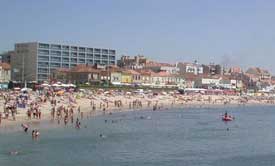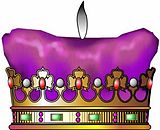Anna Nzinga (1582-1663), queen of Matamba-Ndongo, dominated the
 history of current Angola during thirty years until her death at 82 years old, and opposed a fierce resistance to the Portuguese, who eventually respected the borders of her kingdom. The Portuguese had found in Angola an unusually fertile territory, occupied by a population highly productive and trading in agricultural products, furs and diamonds. After fighting for a century they conquered the coastal part of the country, establishing an important exporting centre of diamonds and slaves in Luanda. Being sister of the king Mani Ngola, Nzinga was sent to negotiate with the viceroy Joao Correia Da Souza, and proved so skillful that passed from a defeat situation to the achievement that Portuguese removed their troops from Matamba. In 1624 she succeeded her brother as a queen, and faced Portuguese offensives without losing any territory, she reorganized the army, formed alliances with neighboring countries (and also with Netherlands) and constituted an efficient secret police.
history of current Angola during thirty years until her death at 82 years old, and opposed a fierce resistance to the Portuguese, who eventually respected the borders of her kingdom. The Portuguese had found in Angola an unusually fertile territory, occupied by a population highly productive and trading in agricultural products, furs and diamonds. After fighting for a century they conquered the coastal part of the country, establishing an important exporting centre of diamonds and slaves in Luanda. Being sister of the king Mani Ngola, Nzinga was sent to negotiate with the viceroy Joao Correia Da Souza, and proved so skillful that passed from a defeat situation to the achievement that Portuguese removed their troops from Matamba. In 1624 she succeeded her brother as a queen, and faced Portuguese offensives without losing any territory, she reorganized the army, formed alliances with neighboring countries (and also with Netherlands) and constituted an efficient secret police.Amina, queen of Zazzua (1533-1610) is known as a great warrior queen from Nigeria. Amina's mother, Bakwa of Turunka, was already queen of Za
 zzua, a Hausa state-city, title already hold by her grandfather. Amina was educated in government and warfare skills, and fought in battles together with her brother Karama, who became king at his mother's death. When he died in 1576, Amina succeeded him when she was 43 years old. She used her strategic skills to expand the territory of Zazzua to the mouth of the Niger, and towards Kano and Katsina northwards. These conquests lead to a stage of wealth to the kingdom, with the opening of new trade routes and the arrival of new tributes. Mud walls were risen in all the cities, still known nowadays as "Amina's walls". The queen refused to marry and had no children.
zzua, a Hausa state-city, title already hold by her grandfather. Amina was educated in government and warfare skills, and fought in battles together with her brother Karama, who became king at his mother's death. When he died in 1576, Amina succeeded him when she was 43 years old. She used her strategic skills to expand the territory of Zazzua to the mouth of the Niger, and towards Kano and Katsina northwards. These conquests lead to a stage of wealth to the kingdom, with the opening of new trade routes and the arrival of new tributes. Mud walls were risen in all the cities, still known nowadays as "Amina's walls". The queen refused to marry and had no children.In the kingdom of Waalo, in Senegal, next to the French colony of Saint-Louis, the queen Ndete Yalla managed to maintain her territory in peace during ten years and imposed a tax to French settlers when they used transport in
 the Senegal river, and when it ceased to be respected, immediately ordered in 1855 the expulsion of all strangers, which meant war. In the current Ivory Coast, a woman, Pokou, took the leadership of her tribe, known as Baoulé, to save them from extermination, when the Ashanti confederation of Ghana, founded by her great-uncle, broke up, in a tragic exile that later became a legend.
the Senegal river, and when it ceased to be respected, immediately ordered in 1855 the expulsion of all strangers, which meant war. In the current Ivory Coast, a woman, Pokou, took the leadership of her tribe, known as Baoulé, to save them from extermination, when the Ashanti confederation of Ghana, founded by her great-uncle, broke up, in a tragic exile that later became a legend.Some queens were not exempt from cruelty. In Madagascar, the queen Ranavalona took the power when her husband, the king Radama, died (murdered by her orders, as it is believed). She ordered Christian missionaries in the island to be executed, decreed the expulsion of all strangers in 1857, and formed a kingdom of terror in which thousands of executions were carried out per year. It is also told that, in the territory of the Dschaks, in the inner Congo, once arised a queen who, after overthrowing her mother and killing her son, formed a female kingdom in which men were enslaved, sacrificed or assassinated. Pregnant women had to flee from the land until they gave birth, only if they brought back a little girl. The subsistence of her kingdom, lacking agricultural activity, was possible for several years with the sacking of neighboring people and villages, with who they did not cease to fight.
There were prophet women, too, such as Kahina, a berber priestess from Mauritania, who became the leader of her country's army and caused the first major defeat to Arabs in 690. Kimpa Vita in Congo, in the 17th Century created a religion that mixed Catholic and African concepts, which attracted the support of a great part of Congolese aristocracy to expel strangers from the country. She was accused of sorcery when she was 24 years old and burn alive together with her child.
Apart from politics, African women have had and still have an important role in economy. African women have always been excellent in domestic resources organization, because of the traditional complete lack of interest from husbands. This has allowed women to eventually create trade networks in order to focus these organizational skills and communication talents. Nowadays, 80% of autonomous business in sub-saharan Africa are carried by women, and there exist important women trade networks such as those in Accra (Ghana) and Nairobi (Kenya). Historically, it should be noted about the life of Tinubu, in the 19th Century, a Yoruba woman who started selling corn mush and later, with the support of a group of wholesale traders, created a business of slave traffic, that she abandoned when abolition spread and started trading palm oil. She eventually became the main mediator of Euro-African trade of the area, and thanks to her growing influence, became the main advisor of the king of Lagos. After being banished from the kingdom by the British, she acquired wealth with the arms trade and became a heroine of her home city Abeokuta in the resistance against the Europeans and the neighboring kings of Dahomey.





































